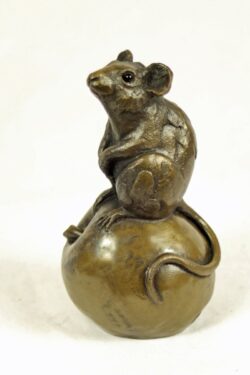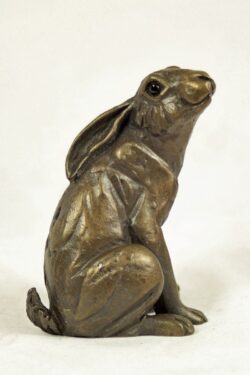Description
bronze resin Hare Sitting Upright
This Hare sitting upright looks fairly relaxed as if all is well in his world, but he’s still got his ears pricked up, listening out for anything untoward. He might look settled but he can be off in the blink of an eye at the first hint of danger.
Hares
Hares are one of British Wildlife’s most mysterious and elusive creatures, for most people rarely seen and even then rarely sitting still. There are many interpretations of them, by many artists. I hope you like mine which I think are fairly realistic, but with a twist that’s personal to me. I have been making ceramic hares for some years, but their appeal does not seem to wane. Hares are still the most popular animal that I sell, and make perfect gifts and Christmas presents. The bronze resin hares are available in several sizes and poses, including tiny ones.
Hares are a golden-brown colour, with a pale belly and a white tail. The Brown Hare is larger than the Rabbit, with longer legs and longer ears with black tips.
Brown Hares graze on vegetation and nibble bark from young trees and bushes. Hares shelter in a ‘form’, which is simply a shallow depression in the ground or grasses, but when disturbed, can be seen bounding across fields, often in a zigzag pattern. They are commonest in grassland and at woodland edges.
The brown hare is predominantly nocturnal, spending most of the day in their form. At night the hare ventures out, grazing on the young shoots of grasses and herbs as well as agricultural crops. Hares escape predation by outrunning their enemies; with their powerful hind legs they can reach speeds of up to 45 miles per hour.
In early spring, Brown Hares are at their most visible as the breeding season encourages fighting or ‘boxing’, this well-known ‘mad March hare’ behaviour actually involves unreceptive females fending off amorous males. Breeding usually occurs between February and September, females typically give birth to around three litters each year of two to four young (leverets). Leverets are born with their eyes open, and are left alone in the day in forms to avoid attracting predators. The mother returns at sunset and the leverets gather around her to suckle.
The brown hare is widespread throughout central and western Europe, including most of the UK, although it is absent from the northwest and western highlands in Scotland, where the species is replaced by the mountain hare. It is likely that the Romans introduced the brown hare to Britain, as there are no records of this species before Roman times. Recent surveys show the brown hare has declined by more than 80% during the past 100 years and the decline is ongoing. In some parts of Britain, such as the South-West, the brown hare is almost a rarity and may even be locally extinct.
The reasons for this decline are not entirely clear, but intensification of agriculture has certainly been a major factor.
Hares do not hibernate or store appreciable amounts of fat in their bodies and so need a constant food supply throughout the year. This can only be provided by landscapes rich in biodiversity. Agricultural landscapes, including traditional hay meadows and crops grown in rotation, provided similar diversity in relatively recent times. But 95% of hay meadows have been lost since the Second World War. Hay making has largely been replaced by silage production which is more profitable and less dependent upon weather conditions. Grassland for silage production tends to be sown to a single species, resulting in landscapes poor in biodiversity. This might explain why hares are now particularly scarce in western areas where dairy farming predominates. They now fare better in the arable areas of the east, giving a marked east-west divide in their national population.
Hares prefer to eat wild grasses and herbs, with grasses predominating in the winter and herbs in the summer, but 150,000 miles of hedgerow have been destroyed during the past 50 years – depriving hares of this source of food and shelter. Larger fields containing single crops also mean hares have to travel further in their effort to maintain continuous grazing.
Shooting and coursing have also had an impact on hare numbers. Despite its decline, the hare is the only game species in Britain which does not have a shooting close season. You can help hares by joining your local Wildlife Trust or the Hare Preservation Trust
The ceramic hares are made individually and will vary slightly from the photo
Resin Bronze Sculptures
When I make a sculpture I particularly like, I Have it moulded and cast in Bronze Resin. A process that creates an attractive and durable alternative to real bronze. The bronze resin animal sculptures have proved to be very popular as they are affordable and easy to send and I am continually adding to the range. My work is also available in galleries, mainly in the Westcountry.
Links
If you would like to find out more you can also check out my Facebook Page. Every year for Dorset Art Weeks I coordinate several like-minded artists and transform my home into a gallery. Check out the Horethorne Group facebook page as well for all the latest news.





